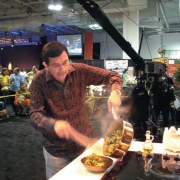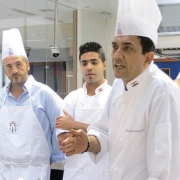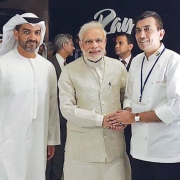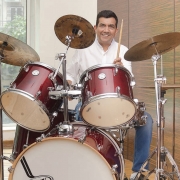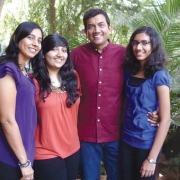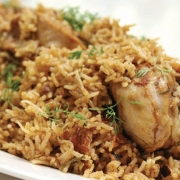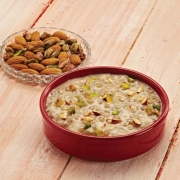
People
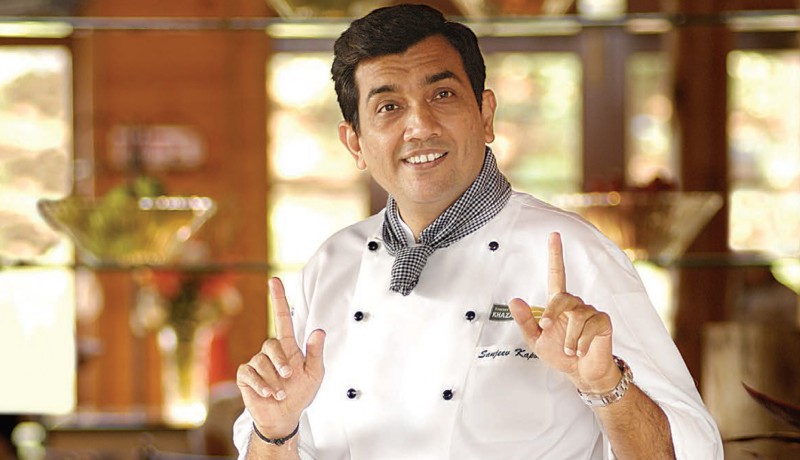
If the timeline of contemporary Indian cuisine can be divided into two zones, one would be before Sanjeev Kapoor and the other, after! With his hugely popular TV food shows, cookbooks and presentations on varied platforms, the culinary master has left an indelible mark on our home kitchens. In conversation with Sai Prabha Kamath, he shares his relentless pursuit for innovation and explains how reinvention is his recipe for success
On a breezy monsoon afternoon, the prominent industrial estate area of Andheri West in Mumbai is abuzz with life, its narrow by-lanes filled with the familiar sights and sounds of street-food vendors, office-goers, movie buffs and whizzing vehicles. This neighbourhood is home to notable production houses Yash Raj Films and Balaji Telefilms, the star-makers of the entertainment industry. Not far from them is the office-cum-studio of chef-turned-entrepreneur Sanjeev Kapoor, a celebrity in his own right.
As Team Harmony enters his cabin and introductions are made, the master chef—looking dapper in a white Chinese-collar shirt and denims—greets us with his trademark smile. Cookware sets of different shapes and sizes line his huge working desk, showing signs of his previous meeting. A mini library, sculptures and, surprisingly, musical instruments such as drums and a keyboard find pride of place in the room, displaying his wide-ranging interests. However, the master chef has his priorities right: “I want to make Indian cuisine the No. 1 on the world culinary map!” A trailblazer in the Indian food industry, Kapoor was awarded the Padma Shri earlier this year in recognition of his culinary contribution.
This phenomenal journey began when Kapoor hosted cookery show Khana Khazana in the early 1990s—a time when the kitchen was a female preserve. His pleasing demeanour and simple-yet-modern rendition of traditional recipes made him one of TV’s most popular faces within no time and the show went on to become the longest running show of its kind in India.
The chef’s rediscovery of the culinary secrets of India continued unabated with his myriad cookbooks—to date, he has authored over 200 cookbooks in seven languages, the latest being 100 Mouthwatering Recipes. Further, his books intended for an international audience—such as How to Cook Indian (April 2011)—printed and published in the US and the UK, received a tremendous response. While The Yellow Chilli Cookbook was adjudged the ‘Best International Cookbook’ at the 2012 International Book Awards, another book, aah! Chocolate, received the ‘Best in the World’ award at the Gourmand World Cookbook Awards 2014 in Beijing.
Over time, the chef turned entrepreneur, expanding his presence in the culinary market with a range of foods such as pickles, blended masalas, gourmet chutneys and ready-to-eat mixes under the brand name ‘Sanjeev Kapoor’s Khana Khazana’; in 2009, he launched Wonderchef, a range of cookware and kitchen appliances. As a restaurateur, he has 70 eateries globally (including franchisees) such as Khazana, The Yellow Chilli, Signature, Sura Vie and Hong Kong under his company SKR (Sanjeev Kapoor Restaurants), making Indian food accessible across the world.
Further, he endorses many a brand, such as Ariel, Tata i-Shakti Dals and Sleek Kitchen, and is on the board of Singapore Airlines’ International Culinary Panel, rubbing shoulders with the who’s who of the culinary world. The first chef in the world to launch his own TV channel FoodFood, he divides his time between India and the rest of the world, participating in live food events and cooking demonstrations. While his portal www.sanjeevkapoor.com has a compendium of over 15,000 tried-and-tested recipes and food-related information, his channel on YouTube has garnered 1.4 million subscribers. He runs his own blog, chefsanjeevkapoor.blogspot.in, and is active on social media too. What’s more, to nurture young talent, he has started the Symbiosis School of Culinary Arts in collaboration with Pune’s Symbiosis University, which offers a bachelor’s degree in culinary arts.
Amid all this, the 53 year-old’s quest to dish out new culinary experiences and “do things differently” remains alive. For instance, he tells you how he recently gave the Punjabi samosa—meant for the export market—a twist by adding a stuffing of beetroot mixture. The result: healthy beetroot samosas! Inspired by the idea, the same day, he surprised his guests at home by blending beetroot and adding a dash of pink to dahi bhalle. “I love to experiment; nature and ingredients are beautiful toys to play with,” he says. Indeed, reinvention comes easy to this Ambala-born Punjabi. “I have an open mind; I travel and observe a lot. I taste everything on my way and can never be bound by scripted recipes.” Nor is he bound by straitjackets—upon our request, the friendly host was happy to show us his musical side when he strummed the percussion instrument in his cabin.
EXCERPTS FROM THE INTERVIEW
What is your definition of ‘cooking’?
Cooking to me is what a canvas is to a painter—an art form arising from the creativity deep within, urging me to give every dish a new hue and perspective. I love to keep my creations simple so they can be understood by maximum people. Combining the best of tradition with a touch of relevance using the freshest local ingredients, backing it up with the science of creating that art… the end result of this experience simply has to be nirvana!
What are your earliest memories in the kitchen?
My father used to cook non-vegetarian food as my mother was a vegetarian. My earliest memories in the kitchen are of me, just seven or eight years old, helping my dad roll out chapattis. To give them a perfect round shape, I would use a saucer after rolling out the dough in various shapes!
You are one of the pioneers of food shows on Indian television. Tell us about the experience of cooking for the camera.
When I started, I had a tough time changing the mindset of people towards the profession. Change came gradually! My show was named Shriman Bawarchi and I put my foot down asking them to rechristen it. Then, the channel producers insisted on having a female hostess standing next to me while I was cooking; again, I found it a big deterrent to my cooking and connect with the audience. After many discussions, they agreed to rename the show Khana Khazana, which went on to run for almost two decades. All the recipes were cooked on the set and there were no repeats. I used to cook them exactly as the audience would want. All my shows were and are, to date, unscripted; I always speak extempore. Also, my technical knowledge in aspects such as the sound and camera helped. The final factor is luck. God has been kind, people have accepted me and I have been able to continue with the same sincerity with which I did my first show.
Where did you draw your inspiration?
From my family and the books written by eminent food historian K T Achaya and American author Harold McGee, who writes about the science of food and cooking.
What was the biggest turning point in your life?
The biggest turning point was when I opted for hotel management as a career while almost getting into architecture. I’m glad I trusted my instinct and took the food way!
Indeed! Could you share a few memorable moments of your career?
Opening my first restaurant, Khazana, in 1998 in Dubai; launching my own TV channel FoodFood in 2011; cooking an exclusive Gujarati menu for Prime Minister Narendra Modi in an Arab nation; receiving the Padma Shri this year from the President of India… these are some special moments I just cannot forget! Apart from these, the list is quite exhaustive.
The late ‘recipe queen’ Tarla Dalal was the inspiration for your cookbooks, we hear….
It was my zeal to do different things at different times in life. Even cookbooks were a result of that.
Are the food tastes of Indians evolving today?
Even as we are tasting the so-called new, exotic foods from around the world, our food tastes haven’t changed much. We still consume foods with basic tastes [bitter, salty, sour, sweet]; only their form and shape are changing. We have Indianised international recipes to suit our palate; for example, masala noodles, aloo tikki burger, tandoori chicken pizza. The talk has been much more than real consumption.
Food wisdom appears to run in cycles. What was once said to be good for you is bad today, and bad turns out to be good! For instance, there are different theories on rice, wheat, ghee, coconut, eggs, etc, these days. How does one stay ahead of the curve and make the right choices?
According to me, one must eat everything as something may or may not suit a particular body, and this will differ from individual to individual. What one must ensure is to exercise and indulge in physical activities regularly for a balanced, stress-free life.
How does one balance nutrition and taste?
The key to balancing nutrition and taste lies in using your intelligence and knowledge of science and cooking. It’s a misnomer that healthy food is not tasty. Each and every food, irrespective of whether it falls in the category of healthy or junk, can be and should be made tasty. Fight calories, not taste!
With the advent of international cuisines in the country, how can Indian cuisine hold its own ground?
The food scene in India and, for that matter, the world is on an all-time boom. There are some exciting concepts and great food being dished out. Even regional flavours are right there in the market. It’s a raging trend already. The future of Indian cuisine is shining bright like a diamond! The entire chef community, including me, is doing its best to preserve our food heritage along with making it popular across the globe. Indian cuisine was, is and will always stay in vogue.
What does the rest of the world think about Indian cuisine?
Indian food is a mystery for the world; the general impression is that we make hot, spicy curries that are complex to cook. For me, Indian cuisine can be divided into two categories: homemade and restaurant-made. The world has only seen and tasted restaurant-made food and not explored anything beyond it. However, these days, with different media showcasing real Indian homemade food, the world is opening its eyes to the authentic Indian kitchen. This is, indeed, an encouraging trend.
The new globalised India brought in the trend of eating and drinking out like never before. However, today, the TV offers a smorgasbord of cookery shows and the virtual world has a deluge of ‘snack-sized’ recipe videos. Will this trend put the spark back in the home kitchen?
It already has! Also, since the time I’ve been on TV, I’ve always demonstrated recipes that can be easily done in our home kitchens. No food can ever match that prepared with love at home.
What’s cooking next?
We are doing research on launching new products, such as cordless grinders, and smart kitchen appliances and cookware under our Wonderchef brand. Also, we are trying out new, interesting concepts for the digital platform. In the near future, we will look at expanding the reach of the FoodFood channel into the Indian regional market as well as increasing its presence in the international market. For other things, you’ve got to wait and watch!
What are your favourite food shows on TV—Indian and international?
I like Mummy ka Magic and the Out of the World series on FoodFood and Chef’s Table on Netflix, besides many more on various channels.
How has your wife Alyona supported you in your endeavours? Do you have any common interests?
Alyona’s multitasking art of managing me, home, kids, my mother, her parents, extended family, friends, office, business partners and finances is commendable. Had she not donned these hats so beautifully, I wouldn’t have reached where I am today. I am extremely blessed and thankful to God for this. She’s been my pillar of support, love and care all these years. Food, indeed, is our common interest!
We guess that was the genesis of her online food show Family Food Tales….
Yes, as the name suggests, she brings you a collection of recipes that are most loved by our family and friends. Also, Alyona shares her experience and personal anecdotes related to each recipe she dishes up on the show. For more, tune into sanjeevkapoorkhazana on YouTube every Tuesday!
What do your daughters Rachita and Kriti do? Are they likely to follow in your footsteps?
You never know! As of now, the elder one has just finished her law degree and the younger one is an athlete, currently pursuing mathematics and statistics in the UK.
How do you look back at your journey? Do you have any regrets?
Whenever I look back and remember the times I started, there’s a smile on my face and immense satisfaction that cannot be put in words! All my hard work, sincerity and dedication have paid off and brought me to where I stand today. Not to forget, the ones who stood by me and believed in my capabilities throughout. Also, I’m the kind who owns up to everything in life and takes each phase—good or bad—as a lesson to learn from. Hence, there is no place for regrets in my life.
What are your other interests?
Reading books, mainly related to ancient food wisdom, listening to music of different genres and learning anything new.
You also run two CSR initiatives: one for woman entrepreneurs and another for autistic schoolchildren. Please tell us more.
As I am in a position where I can reach out to society, I believe it is my responsibility to make people aware about certain causes, of which women empowerment and autism are the closest to my heart. Through our venture Wonderchef, we have built a community of women entrepreneurs in the food world. It has enabled women across the country to create a business of their own, boosting their pride, worth and, not to forget, family income. I truly feel women should be independent, not just financially but emotionally. And during my decade-long interaction with autistic children, I’ve realised there is a lot of insensitivity, when what they need is a little more love and care. This is where I became committed to spreading awareness about this cause. Running a marathon is one way to create awareness. I support Forum for Autism; whenever and wherever they do something for the cause, I try to be there.
Please share your views on ageing.
With increasing life expectancy, the definition of old age has changed—60 is the new 40 and 70 is the new 50! As we age, we need to be independent—physically, financially and emotionally. As we are what we eat, food is a major contributor to our health. Eat healthy, stay fit and believe in the power of positivity.
What are your plans for old age?
It’s still a long way away. I would rather concentrate on my present as of now!
HEALTHY, SILVER-FRIENDLY RECIPES FROM SANJEEV KAPOOR’S KITCHEN
QUICK CHICKEN PULAO
Ingredients
- Boneless chicken: 600 gm; cut into 1-inch pieces
- Basmati rice: 1½ cups; soaked for 1 hour
- Yogurt: ½ cup
- Ginger-garlic paste: 2 tbsp
- Salt to taste
- Ghee: 4 tbsp
- Cumin seeds: 1 tsp
- Cloves: 6-8
- Cinnamon sticks: 2; 1-inch each
- Green cardamom: 6-8
- Bay leaves: 2
- Onions: 2 medium; sliced
- Tomatoes: 3 medium; chopped
- Red chilli powder: 1 tsp
- Chicken stock: 3½ cups
- Fresh coriander sprigs for garnishing
Method
Marinate the chicken in yogurt, ginger-garlic paste and salt for an hour. Heat the ghee in a non-stick pan. Add the cumin seeds, cloves, cinnamon, cardamom and bay leaves and sauté for 10 seconds. Add the onions and sauté till golden brown. Add the tomatoes and sauté on high heat for 3 minutes, stirring continuously. Add the chilli powder and mix. Add the chicken along with the marinade and sauté till the chicken is half cooked. Add the chicken stock and bring the mixture to a boil. Drain the rice and add. Stir and bring to a boil again. Reduce the heat and cook till the water level reaches the rice level. Cover and cook on low heat for 20 minutes or till rice and chicken are completely cooked. Remove the lid and stir lightly to separate the rice grains. Serve hot, garnished with coriander sprigs.
TENDER COCONUT AND SAGO KHEER
Ingredients
- Chopped tender coconut: 1 cup
- Sago:½ cup; soaked
- Palm jaggery: ¾ cup; grated
- Green cardamom powder: ½ tsp
- Coconut milk: 3 cups
- Pistachios: 10-12; finely chopped
- Almonds: 10-12; finely chopped
Method
Heat 2 cups of water in a non-stick handi. Add the sago and cook on low heat for 10-12 minutes or until it is cooked. Add the palm jaggery and cardamom powder and stir on low heat till the jiggery dissolves completely. Add the coconut milk and mix. Cook for 2-3 minutes. Add the tender coconut, half the pistachios and almonds, and mix. Stir and cook for 5-7 minutes or till the kheer thickens.
Transfer into a serving bowl, decorate with the remaining pistachios and almonds and serve.
QUICK BITES
Dishes your wife makes better than you
Masala dosa and undhiyo
All-time favourite food
Anything and everything Indian!
Signature dish
- Shaam savera – Spinach koftas filled with creamy cottage cheese on a bed of velvety tomato gravy
- Lalla mussa dal – Black lentils simmered for 36 hours on a slow fire
- Gulab-e-Gulkand – Gulab jamun stuffed with rose petal compote
Comfort food
Rajma chawal and kadhi chawal
Wackiest meal you have ever had
Grilled sea dragon in Beijing
Ingredient you cannot live without
Salt
Food item you detest
None!
Fusion food
Fun, but overrated
Photographs courtesy: Sanjeev Kapoor Featured in Harmony — Celebrate Age Magazine September 2017
you may also like to read
-
For the love of Sanskrit
During her 60s, if you had told Sushila A that she would be securing a doctorate in Sanskrit in the….
-
Style sensation
Meet Instagram star Moon Lin Cocking a snook at ageism, this nonagenarian Taiwanese woman is slaying street fashion like….
-
Beauty and her beast
Meet Instagram star Linda Rodin Most beauty and style influencers on Instagram hope to launch their beauty line someday…..
-
Cooking up a storm!
Meet Instagram star Shanthi Ramachandran In today’s web-fuelled world, you can now get recipes for your favourite dishes at….



